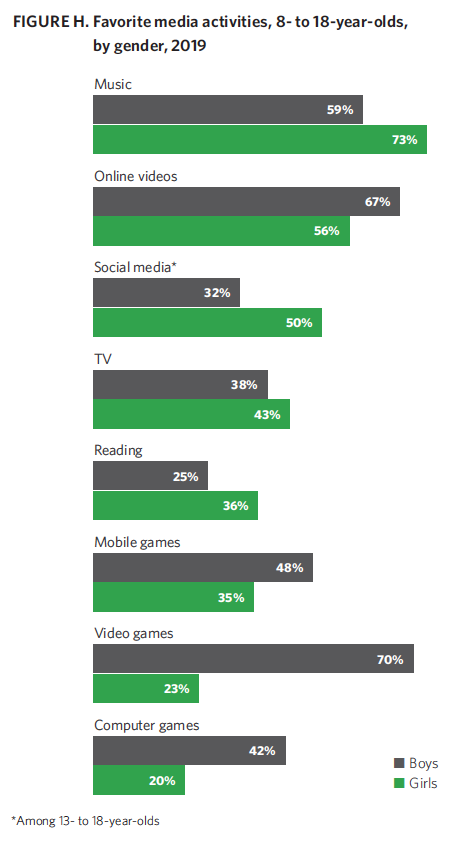
Teen Media Consumption Trends in 2019
Common Sense Media just released the findings of their 2019 teen media consumption survey, cataloguing teenagers’ continuously evolving media usage patterns. The report compares and contrasts 2019 media habits among teenagers aged 13-18, against 2015 teenage media habits. It also includes media habits of tweens (aged 8-12), but for the sake of this post, we’ll stick with teenage trends.
For many in the marketing field, Common Sense’s findings were largely in line with our expectations. However, as always seems to be the case, certain findings did come as a surprise, upending some of our of standard assumptions. Here are the insights we found most interesting.
Teens are using various screens nearly 7 and a half hours a day.
If you think that number sounds crazy, consider this: the 7 hours and 22 minutes of average daily screen time teens reported in the study does not include time spent on screens for school or homework.
“Screen time” has historically been a term used to classify on-screen activities pertaining to entertainment and idle time. But the term is being reevaluated, as screen time has become an increasingly more all-encompassing activity, including a number of essential educational utilizations.
Another interesting and potentially counter-intuitive segment of this finding comes when screen time is filtered by family income. There are substantial differences in the teens’ screen time, depending on their socioeconomic group. Teens in lower income families spend an average of 1 hour and 43 minutes more per day on screens than teens in higher income families.
The amount of time teens spent watching online videos between 2015 and 2019 doubled.

Teens LOVE watching videos. And no, not on TV. Instead, they’re crushing hours of content on YouTube. Whether the content is a tutorial based channel, a make-up stylist, a gamer, or anything in-between, teens are burning through online video content at a blistering pace. Between 2015 and 2019, the number of teens who reported watching online videos every day jumped from 34% to 69%. The jump is consistent for tweens aged 8- 12 as well, indicating that this growth could still be ballooning. This trend also goes hand-in-hand with another finding that is putting even more pressure on traditional cable companies: the number of teens reporting watching TV live on a TV set dropped from 48% in 2015 to 24% in 2019. On-demand and searchable video content is nothing new, and it’s clearly becoming a standard expectation among younger audiences, whose viewing habits are undoubtedly ushering in a new era of home entertainment.
Despite the increase in screen time, social media usage has remained relatively steady.
In what may be the most surprising finding of this survey, teen social media usage has remained steady despite the increase in screen time. Between 2015 and 2019, the average time reported using social media actually dropped 1 minute from 1 hour and 11 minutes per day to 1 hour and 10 minutes per day. However, between 2015 and 2019, the number of teens reporting they check social media every day has jumped from 45% to 63%. So it appears that teens are picking up their phones to check social media more frequently, but in shorter stints.
Teens are largely content consumers; not creators.
The recent boom in screen time has not translated into time spent creating content for a large majority of teenagers. Teenagers reported only spending about 3% of time on their devices creating their own writing, art or music. This finding comes as a slight surprise, particularly due to other studies that recently reported US teens’ most desired job is becoming a famous Youtuber. It appears as though that career aspiration has yet to physically manifest itself in a substantial way, since teens are still consuming far more content than they’re creating.
Girls and boys do things differently.

With regards to screen time, the biggest disparities between boys and girls came from primarily two categories: video games and social media. Boys enjoy all types of gaming, but for video games specifically, boys spend an average of 1 hour and 19 minutes a day playing video games, compared to girls, who spent an average of just 14 minutes a day gaming. On social media, girls average 1 hour and 30 minutes a day while boys average 51 minutes. Girls also report enjoying social media more than boys, with 50% of girls saying they “enjoy social media a lot” compared to 32% of boys who reported the same. According to Common Sense’s findings, you’re more likely to find a girl using her various screens to listen to music, surf social media, watch TV, or read, and you’re more likely to find a boy using his screens to play video games, watch online videos, or play a mobile or computer game.
Today’s teens are tomorrow’s adults, and this study suggests that the future will be spent largely online. How that online time is filled though, is always subject to change. The biggest takeaway from this study is teens’ and tweens’ burgeoning interest in online video content, particularly YouTube.
It’s safe to assume that the core of the entertainment package is going to continue shifting towards on-demand, long-form content. Individual vlogger personalities are going to wield greater influence and more of them will likely be popping up in conversations traditionally reserved for superstar athletes and actors/actresses. Whether you’re accessing this information as a marketer, a parent, or anything in between, it’s extremely important to be cognizant of these trends so you can proactively navigate this changing landscape.